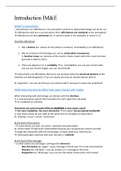Introduction IM&E
WHAT is interactivity
= interactivity is an affordance (= the perception of what an object/technology can do for us)
à affordances exist bcz a user perceives them (affordances are relational to our perception)
à affordances are also contextual (ex. in summer water is not walkable, in winter it is)
Checklist affordance:
1. Not a feature (ex. camera on the phone is a feature, recordability is an affordance)
2. Not an outcome of technology use, not an unintended consequence
(= function creep: ex. cameras at the coast to check crowd control for covid, but also
got used to detect crime)
3. There are degrees in it (= variability à ex. recordability: you can just record audio,
you can just record images, you can record both)
à Interactivity is an affordance that users can perceive when the structural features of the
interface are well designed (= if we can clearly see how we should interact with it)
Ex. Hyperlink = you can see that you can interact with it because it is blue and underlined
HOW does interactivity affect how users interact with media
When interacting with technology, we interact with the interface
(= a communication system that translates the user’s goal into outcomes
à ex. keyboard on a phone)
Interaction can come through different modalities (= text, audio, visual)
à the more modalities, the more interactive à the higher the perceptual bandwidth
(= how many senses do you need at the same time to complete an interaction)
Ex. Swiping = touch + visual + movement
At the level of the source:
= To what extent can wen (as users), customize and personalize.
Ex. social media à high level customization because you can generate content yourself
Through the interaction with the technology, it knows what your interests are
à information gets matched with your interests (= tailored)
At the level of the message:
= to what extent are exchanges contingent (= coherent)
- Non-interactive (ex. pager = every message is brand new à no real conversation)
- Reactive (ex. old Nokia = you can answer on 1 message at the time)
- Responsive (ex. Whatsapp = you can see the whole conversation and answer)
,Summed up:
Interactivity is situated at the level of the source (= ourselves), the medium/modality and
the message.
This makes the user engage with content
à which has an effect on: cognition, attitude and behavior
3 broad media types:
- Communication technologies (= ex. social media)
- Self-tracking technologies (= ex. wearables, Strava)
- Entertainment technologies (= ex. Robots, etc.)
Influence of Interactivity on society
(= sociological perspective)
More and more human agency through social media. Society is a duality between the
determined structure and the human agency. Power is distributed and negotiated in society
(Ex. MeToo à thanks to social media, stories go viral quickly, and they get support)
Technologies can directly affect, and reproduce existing social structures. Their affordances
introduce new ways of doing things
(Ex. Blauwe vinkjes whatsapp berichten à people expect an answer quickly and you can’t
deny that you haven’t seen the message)
Computer-mediated communication (CMC)
The internet paradox
= The purpose of internet is to be more social, but it actually leads to more loneliness and
depression
Why?
- Time displacement theory à the time you spend on interactive media (smartphone),
you don’t spend on other activities (ex. hobbies)
- CMC theory à Real social contact > virtual social contact
BECAUSE a lot of cues are filtered OUT (eye contact, body language, immediate
feedback, you don’t always know who you’re talking to etc.)
à Text-based CMC is perfect for instrumental tasks, but not for efficient interpersonal,
social communication. As it requires high social presence.
, CMC theories (revisited)
= There are also cues filtered IN
Social information processing theory = people are more motivated to get a good
conversation, they do the effort. There is also a reduction in interpersonal uncertainty,
because people can see a whole profile of who they are talking to.
à Time strongly determines the level of relational development
Ex. you don’t answer immediately à slower development/bad development
Deindividuation theory = a lack of awareness of one’s own (and other’s) self-identity due to
anonymity. Due to the lack of individuating, people will focus more on ‘group norms’ than on
their own ‘personal norms’.
Internet paradox (revisited)
= CMC benefits our well being, but only for extraverts
True, but it can also benefit introverts, while they compensate for their lack of interaction in
real life with online interaction à depends on what you do online
Social media, social capital?
Social capital = all your resources that benefit an individual
(strong ties = emotional support à family
weak ties = networking; “via via”)
Positive connection between social media & social capital
à it’s easier to get in contact with other people and build larger networks
= larger social capital, through social media you can build a social ‘super-net’
(with strong and weak ties), but only if they use direct communication via CMC (active use)
Increase in bonding (online) à less bonding in real life (with strangers)
à There is bounded solidarity = we only help the people that we know, there is less and less
solidarity towards ‘strangers’ (= ‘floating worlds’, we only help our loved ones)
Mobile Communication
NETWORK LOGIC
Space of flows concept = communication is no longer bound to space and time (ex. you can
watch a livestream at home, at a later point in time) à it makes people autonomous.
You can do things ‘on the go’, you don’t need a specific time and place to do something
(ex. signing a document and sending it through whatsapp)
Timeless time = activities aren’t sequentially in time anymore à more multitasking through
mobile phone. Therefore time is flexible: activities organized around flexible time (you don’t
plan a lot ahead because plans can change)




